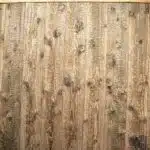As a wood repair expert, I have encountered many instances where homeowners and DIY enthusiasts struggle with the issue of rotting wood. Rotted wood not only diminishes the aesthetic value of a property but also poses a potential safety hazard. Failure to address this problem can lead to structural damage and costly repairs in the long run. In this article, I will provide you with practical tips on how to repair rotted wood effectively.
The first step in repairing rotted wood is identifying the cause of decay. Decay can occur due to exposure to moisture, fungal growth or insect infestation. Once you have identified the cause of decay, it is important to remove all the affected areas using appropriate tools such as chisels or saws. After removing the damaged portion, you need to treat the remaining wood with a preservative solution that prevents further decay. Finally, you can fill in gaps and cracks with an epoxy filler or replace any missing pieces with new wood that has been treated with preservatives. With these steps, you can restore your wooden structures and prevent further damage while improving their longevity and durability.
Understanding The Causes Of Wood Rot
Wood rot is a common problem that can affect any wooden structure. According to recent studies, over 10% of all wood structures in the United States are affected by rot. This is a significant number that highlights the importance of understanding the causes and preventive measures of wood rot.
Preventive measures are crucial when it comes to avoiding wood rot. The most effective way to prevent this problem is to control moisture levels around wooden structures. Moisture is one of the common culprits that cause wood rot. A high level of humidity, water leaks, or poor drainage can create an ideal environment for fungi and bacteria to grow and thrive on wood surfaces.
Other factors that contribute to wood rot include poor ventilation, inadequate sealing, and exposure to direct sunlight. These factors can accelerate the process of decay and make it harder for wooden structures to withstand harsh weather conditions. It’s crucial to identify these factors early on and take steps to address them before they cause significant damage.
By understanding the causes and preventive measures of wood rot, homeowners can take proactive steps towards preserving their wooden structures. However, if you suspect that your wooden structure has already been affected by rot, it’s essential to identify the extent of damage before taking further action.
Identifying The Extent Of Damage
Assessing the extent of damage is an essential step in repairing rotted wood. Before deciding on any repair options, it’s crucial to identify the level of damage and how much of the wood has rotted away. This assessment will help you determine if you need to replace the entire piece of wood or if you can repair just a portion of it.
To assess the damage, start by examining the surface of the wood. Look for any signs of discoloration, softness, or holes that may indicate rotting. Use a screwdriver or other probing tool to test the firmness of the wood. If it feels spongy or crumbles easily, it is likely that rot has set in deeper than just the surface layer.
Once you have identified and assessed the extent of damage, you can then consider your repair options. Depending on the severity of the rot, you may be able to fill in small areas with a wood filler product or cut out and replace larger sections with new pieces of wood. In some cases, however, it may be more practical to replace an entire section rather than attempting repairs that are unlikely to last long-term.
Gathering The Necessary Tools And Materials
The key to repairing rotted wood is to gather the necessary tools and materials before starting. This will ensure that the repair process goes smoothly and efficiently. Some of the tools that you will need include a saw, chisel, hammer, screwdriver, drill, sandpaper, and a putty knife. In addition, you will also need some materials such as wood filler, epoxy resin, wood preservative, and paint or stain.
Choosing the right filler is an important step in repairing rotted wood. There are many different types of fillers available on the market today, each with its own advantages and disadvantages. Some of the most common fillers used for repairing rotted wood include polyester filler, epoxy filler, and vinyl spackle. When choosing a filler for your project, it is important to consider factors such as durability, ease of use, and compatibility with your specific type of wood.
When working with rotted wood it is important to take safety precautions during the repair process. This includes wearing gloves and eye protection to protect yourself from any debris that may fly up during cutting or sanding. It is also recommended to work in a well-ventilated area to avoid inhaling any fumes from the materials being used. By taking these simple precautions you can ensure that your repair project is both safe and successful.
With all of your tools and materials gathered and safety measures in place it’s time to move onto removing the rotted wood. By following these steps carefully you can be sure that your repair project will go smoothly from start to finish.
Removing The Rotted Wood
To effectively repair rotted wood, it is important to first remove any damaged areas. This process may seem daunting, but with the right tools and safety precautions in place, it can be done efficiently and effectively. Here are the steps to removing the rotted wood:
Determine the extent of the damage: Before beginning any repairs, assess the area to determine how much of the wood needs to be removed. Use a screwdriver or similar tool to test the softness of the wood and identify where the rot ends.
Tools needed: To remove the rotted wood, you will need a circular saw, reciprocating saw, or handsaw, as well as a pry bar and hammer. Additionally, you may need a chisel or router to remove any remaining debris.
Safety precautions: It is important to wear protective gear such as gloves and safety glasses during this process. Be sure to use caution when handling power tools and always read and follow manufacturer instructions.
By following these steps and taking necessary safety precautions, you can effectively remove all damaged areas of rotted wood from your project. The next step in repairing rotted wood is preparing the surrounding area for replacement materials.
Preparing The Surrounding Area
Before starting any wood repair project, it is essential to prepare the surrounding area. Start by choosing an appropriate sealant based on the type of wood and the severity of damage. For minor rotting, a simple wood filler and primer may suffice. However, for more advanced cases, a two-part epoxy or synthetic filler may be necessary.
Once you have chosen the appropriate sealant, clean the work area thoroughly. Remove any debris, dust or flaking paint from around the damaged area. Use a wire brush or sandpaper to smooth out rough edges and create a clean surface that will adhere well to your chosen sealant.
Keep in mind that safety should always be your top priority when preparing the work area. Wear protective gloves and safety goggles at all times while working with chemicals and cleaning products. By taking these precautions, you can ensure a safe and effective repair process that will restore your rotted wood to its former glory.
Now that you have prepared the surrounding area for repair, it’s time to move on to applying a wood preservative. This step is crucial for preventing future rotting and damage to your restored wood surface. With proper preparation and application techniques, you can effectively protect your investment for years to come.
Applying A Wood Preservative
- When choosing a wood preservative, it is important to consider the type of wood and its condition to select the most appropriate product.
- When applying a wood preservative, the wood should be cleaned and prepped before application to ensure the product adheres properly.
- Once the wood preservative is applied, it should be allowed to dry and cure according to the manufacturer’s instructions.
- After the wood preservative has dried and cured, a sealant may be applied to protect the wood from further damage.
- The most suitable sealant should be chosen based on the type of wood and the environment in which it will be used.
- In order for the wood to be thoroughly protected, the sealant must be applied in accordance with the manufacturer’s instructions.
Choosing A Wood Preservative
When it comes to repairing rotted wood, one of the most important steps is choosing a wood preservative. The benefits of using a wood preservative are numerous, including protecting the wood from future decay, preventing insect infestations, and improving its overall appearance. However, with so many types of wood preservatives available on the market today, it can be challenging to know which one is best for your particular project.
There are several different types of wood preservatives available, each with its own set of advantages and disadvantages. One common type is oil-based preservatives, which are easy to apply and provide excellent protection against water damage. Another popular option is water-based preservatives, which are environmentally friendly and offer long-lasting protection against rot and decay. Finally, there are also borate-based preservatives that work by penetrating deep into the wood fibers to prevent fungi growth.
When choosing a wood preservative for your project, it’s essential to consider factors such as the type of wood you’re working with, the level of exposure to moisture or insects, and any environmental concerns you may have. By doing your research and selecting a high-quality product that meets your specific needs, you can help ensure that your repaired wooden structures will remain strong and durable for years to come.
Applying A Wood Preservative
After selecting the appropriate type of wood preservative for your project, the next step is to apply it correctly. Applying a wood preservative involves several steps that must be followed carefully to ensure maximum effectiveness. The first step is to prepare the surface by removing any loose or flaking paint, dirt, or debris. This can be done using a wire brush or sandpaper.
Once the surface has been prepared, it’s time to apply the wood preservative. Depending on the type of preservative you’ve chosen, this may involve brushing, spraying, or rolling it onto the surface of the wood. It’s important to follow the manufacturer’s instructions carefully when applying a wood preservative and to wear protective gear such as gloves and goggles.
After applying the wood preservative, be sure to allow sufficient drying time before applying any additional coatings such as paint or varnish. The benefits of applying a wood preservative are numerous, including protecting against decay and insect infestations and improving overall appearance. By following these simple steps and choosing a high-quality product that meets your specific needs, you can help ensure that your repaired wooden structures will remain strong and durable for years to come.
Finishing With A Sealant
After applying a wood preservative, the next step is to finish the wood with a sealant. Choosing the right sealant is important because it can affect the durability and appearance of your wooden structures. There are many types of sealants available in the market, including clear, tinted, and colored ones. It’s essential to consider your specific needs, such as UV protection or waterproofing when choosing a sealant.
Once you’ve selected the appropriate sealant for your project, it’s time to apply it correctly. One of the most critical tips for applying sealant evenly is to use a brush or roller that matches the size of the wooden surface you’re working on. This ensures that you can cover large areas without leaving any spots or streaks. Additionally, make sure to apply an even coat across all surfaces and follow the manufacturer’s instructions regarding drying time between coats. These steps can help ensure that your wooden structures are adequately protected from environmental damage and look great for years to come.
In conclusion, finishing with a sealant is an essential step in protecting your repaired wooden structures against environmental damage such as water penetration and UV rays. By choosing the right sealant and following proper application techniques, you can help ensure that your wooden structures remain durable and beautiful for years to come. Remember always to wear protective gear when working with chemicals and read product labels carefully before use.
Letting The Wood Dry
After removing the rotted wood, the next step is to let it dry thoroughly. Drying the surface will eliminate any moisture that may still be present in the wood. If you try to repair it without letting it dry, there is a high chance that your repair will fail as moisture can lead to rotting and decay.
To let the wood dry, leave it exposed to air and sunlight for several days. You can also use a fan or dehumidifier to speed up the process. The aim is to get the moisture content down to around 12% or less before moving on to the next step of repairing the damaged area.
Preventing reabsorption is important because even after drying out, wood has a natural tendency to absorb moisture from its surroundings. Using a moisture meter ensures that there’s no more moisture left in the wood; otherwise, you risk trapping moisture in your repair job, leading to further damage. Here are some tips for preventing reabsorption:
- Keep your work area clean and free of debris
- Cover your work area with plastic sheeting or tarpaulin
- Use waterproof gloves when handling wet materials
- Make sure all tools are clean and dry before using them
- Apply sealant or primer as soon as possible after cleaning and drying
With these precautions taken, you can be confident that you’re working with dry wood that’ll be ready for repair. The next step is applying a wood filler to restore any missing parts of the damaged area.
Applying A Wood Filler
- Before applying a wood filler, it is important to ensure the wood is clean and free of any foreign matter that might interfere with the bonding process.
- Sanding the wood surface with a medium grit sandpaper will help to improve the adhesion of the wood filler.
- Applying the wood filler should be done in small sections, filling the damaged area in multiple stages.
- When the wood filler has dried, sanding it with a fine grit sandpaper will help to create a smooth, even surface.
Preparing The Surface
Proper surface preparation is crucial when repairing rotted wood. Before applying a wood filler, it’s important to ensure that the area to be repaired is clean and free of debris. Begin by sanding the area with coarse-grit sandpaper until all loose paint, dirt, and rough edges are removed. Proper sanding ensures that the wood filler will adhere properly to the surface.
After sanding, use a vacuum or brush to remove any dust or debris from the surface. Then wipe it down with a rag and some mineral spirits to ensure there is no remaining dust on the surface. Once this is complete, you can apply a primer to prepare the surface for the wood filler. Choosing the right primer is critical since it will help prevent further damage from moisture and insects.
When choosing a primer for rotted wood repair, look for one that contains epoxy or other moisture-resistant ingredients. This type of primer penetrates deep into the wood fibers, creating a strong bond that will hold up against weather and pests. Apply two coats of primer using a brush or roller, allowing each coat to dry completely before applying the next one. With proper sanding and priming techniques, your repaired wood will look as good as new!
Applying The Filler
Now that the surface has been properly prepared, it’s time to apply the wood filler. The benefits of using filler are numerous: it fills in gaps and holes, reinforces weakened or damaged areas, and provides a smooth surface for painting or staining. When choosing a wood filler, there are two main types to consider: solvent-based and water-based. Solvent-based fillers are more durable and water-resistant, while water-based fillers are easier to work with and dry faster.
To apply the filler, mix it according to the manufacturer’s instructions until it reaches a smooth consistency. Using a putty knife or spatula, spread the filler over the damaged area in thin layers. Be sure to press the filler firmly into all crevices and corners for optimal adhesion. Allow each layer to dry completely before adding another layer. Depending on the size of the repair area, multiple layers may be needed.
Once all layers have dried completely, use sandpaper to smooth out any rough spots or edges until the repaired area is level with the surrounding wood. It’s important to note that some fillers may shrink as they dry, so additional layers may be needed to achieve a seamless finish. With proper application techniques and attention to detail, your repaired wood will look flawless and last for years to come.
Sanding The Surface
To prepare the surface of the rotted wood for repair, sanding is an essential step. Sanding removes any loose material and creates a smoother surface for the next step of the repair process. Choosing the right sandpaper is crucial for achieving great results.
When selecting sandpaper, consider its grit or coarseness. A lower grit number, such as 60 or 80, is best for removing rough surfaces or paint. Higher numbers like 120 to 220 are ideal for finishing or smoothing surfaces. It’s important to use a sandpaper with a coarseness that matches the task at hand. Using an overly coarse sandpaper can damage the wood or create uneven surfaces.
Tips for sanding curved surfaces include wrapping a small piece of sandpaper around a dowel rod, pencil or other cylindrical object that matches the curve of your surface. This technique allows you to maintain consistent pressure on curved areas without flattening them out during sanding. Additionally, use light pressure when sanding around curves to avoid creating flat spots on your surface.
Now that you’ve sanded down your rotted wood and achieved a smooth surface, it’s time to apply primer before moving onto the next steps in repairing your woodwork. Primer helps seal the sanded area so that any new filler or putty adheres properly and doesn’t absorb into the porous wood below.
Applying A Primer
After sanding the surface, the next step is to prepare the wood for priming. The preparation process involves removing all debris and dirt from the surface. You can use a scraper, wire brush, or sandpaper to remove the loose and flaking paint.
Once you have a clean and smooth surface, choose your primer type carefully. There are several types of primers available in the market, including oil-based primers, shellac-based primers, water-based primers, and bonding primers. Each primer has its unique properties that make it suitable for particular situations.
Before applying any primer type, read the manufacturer’s instructions carefully to ensure proper application. Some primers may require thinning before use or multiple coats for better adhesion. Properly preparing surfaces ensures that your chosen primer adheres appropriately to the wood surface and provides a suitable base for painting or staining later on.
Painting Or Staining The Wood
As the saying goes, “a coat of paint can make anything look new again.” The same is true for repairing rotted wood. Once the damaged area has been properly repaired and treated, it’s time to choose the right finish to protect the wood from future damage.
Choosing the right finish can be a daunting task, but it’s important to take into consideration the environment in which the wood will be exposed. If the wood will be exposed to direct sunlight or rain, an exterior-grade stain or paint should be used. Interior finishes are not suitable for outdoor use as they are not designed to withstand harsh weather conditions. A clear coat can also be used if you prefer a natural look, but keep in mind that it won’t provide as much protection as a colored finish.
Once you’ve chosen your finish, it’s important to apply it correctly. Follow the manufacturer’s instructions carefully and make sure all surfaces are clean and dry before application. Use a high-quality brush or roller and avoid applying too much pressure as this can cause bubbles and streaks. Apply thin coats and allow sufficient drying time between each coat. Applying too thick of a coat can result in drips and an uneven finish.
To really evoke emotion in those who love serving others by taking care of their homes, consider these tips:
- Create a cozy outdoor living space with a warm-colored stain that complements your furniture.
- Make your front door pop with a bold-colored paint that welcomes guests into your home.
- Protect your deck from wear and tear with a clear sealant that showcases its natural beauty.
By choosing the right finish and applying it correctly, you’ll not only enhance the beauty of your repaired wood but also protect it from future damage.
With proper finishing techniques under your belt, preventing future wood rot becomes even more important.
Preventing Future Wood Rot
After repairing rotted wood, it is important to take preventive measures to avoid future damage. One common mistake people make is not addressing the source of the moisture that caused the rot in the first place. This can lead to a recurrence of the problem and further damage. It is important to identify and fix any leaks or other sources of moisture before moving forward with preventive measures.
Another important step in preventing future wood rot is ensuring proper ventilation. This helps prevent moisture buildup and allows any existing moisture to evaporate more quickly. Additionally, it is important to keep wood surfaces clean, as dirt and debris can trap moisture against the wood and contribute to rot over time.
Regular maintenance and inspection are also crucial in preventing future wood rot. Inspect your wooden structures at least once a year for signs of damage or decay, such as soft spots, discoloration, or cracks. If you notice any issues, address them immediately before they worsen. Regularly sealing or painting wooden surfaces can also help protect them from moisture and prolong their lifespan.
Taking these preventive measures can help ensure that your repaired wood stays strong and healthy for years to come. By avoiding common mistakes like ignoring sources of moisture or neglecting regular inspections, you can save yourself time, money, and stress in the long run.
Regular Maintenance And Inspection
- Rotted wood should be checked for decay, using both visual and tactile methods, in order to identify the extent of the damage.
- Once the area of rot is identified, the wood should be treated with an appropriate sealant to prevent further damage and decay.
- A moisture meter should be used to measure the moisture content in the wood to ensure the area is dry and to determine the severity of the rot.
- If the moisture content is too high, the wood should be allowed to dry naturally before applying a sealant.
- The sealant should be applied to the affected area according to the manufacturer’s instructions, with particular attention given to the preparation of the surface.
- The sealant should be regularly inspected for signs of wear and tear to ensure that it is still providing the necessary protection to the wood.
Checking For Rot
As a wood repair expert, the first step in maintaining wooden structures is to check for rot regularly. Rotting wood can pose serious safety hazards if left unchecked, especially in outdoor structures like decks and porches. Common signs of rot include discoloration, softness, and the presence of fungal growth. Prevention tips include sealing wood surfaces with paint or stain to prevent moisture build-up.
To check for rot, one can use a variety of tools such as a screwdriver, awl or knife blade. These tools can be used to probe the wood surface gently and detect any softness or sponginess that may indicate rot beneath the surface. In addition to the probing method, visual inspection is also important. Look for changes in color or texture on the surface of the wood and any signs of fungal growth.
Regular maintenance and inspection are key to preventing extensive damage from rotting wood. By familiarizing oneself with common signs of decay and using proper tools for checking, homeowners can prevent costly repairs down the road. Don’t wait until it’s too late – take action now to ensure your wooden structures stay safe and sturdy for years to come.
Applying Sealants
Regular maintenance and inspection are crucial for keeping wooden structures safe and sturdy. One of the important steps in maintaining wood is applying sealants to prevent moisture damage. There are different types of sealants available, each with its own pros and cons.
Oil-based sealers are common and provide good water resistance, but they can darken the wood’s appearance. Water-based sealers, on the other hand, do not change the wood’s color but may not offer as much protection from water damage. Another option is a penetrating sealer that seeps into the wood fibers, offering excellent protection against moisture damage. However, it does not provide a protective film on the surface of the wood.
Before applying any sealant, it is essential to clean and prepare the surface properly. This includes removing any dirt or debris from cracks or crevices and sanding down rough spots. Additionally, it is important to choose a high-quality sealant product that matches your specific needs.
In conclusion, applying appropriate sealants is an essential part of regular maintenance to protect wooden structures from moisture damage. By understanding the pros and cons of different types of sealers and preparing surfaces correctly before application, homeowners can ensure their wooden structures stay safe and beautiful for years to come.
Checking Moisture Levels
As a wood repair expert, I highly recommend checking moisture levels regularly as part of regular maintenance and inspection for wooden structures. Moisture damage is one of the most common problems that can occur with wood, leading to structural instability, decay, and other issues. Measuring techniques such as using moisture meters can help identify potential problems before they become severe.
Moisture meters are devices that measure the moisture content of wood by sending an electrical current through it. They provide an accurate reading of how much water is present in a piece of wood, allowing homeowners to determine if it is at risk for damage. By checking moisture levels in different areas of wooden structures, homeowners can identify potential problem spots and take action before serious damage occurs.
Regularly checking moisture levels can also help homeowners determine when it is time to apply sealants or other protective coatings to prevent further water damage. If the moisture content of the wood is too high, applying sealant may not be effective or could even trap moisture inside the structure. By using measuring techniques such as moisture meters, homeowners can ensure that they are applying sealant only when it will be most effective in preventing future damage.
Hiring A Professional If Necessary
When to hire a professional for repairing rotted wood is a question that every homeowner or property owner should ask themselves. While DIY methods can be effective in small-scale repairs, larger projects may require the services of a professional. For example, if your home has extensive rot damage or you lack the necessary skills and tools to complete the job, it may be best to seek help from a professional.
DIY vs. professional is also an important consideration when deciding whether to repair rotted wood yourself or hire someone else to do it for you. DIY methods can be cost-effective and rewarding but can also lead to costly mistakes if not done correctly. On the other hand, hiring a professional can guarantee quality workmanship and save time, but at a higher cost.
In conclusion, enjoy your restored wood! Whether you decide to go DIY or hire a professional, repairing rotted wood is a task that requires careful planning and execution. By assessing the extent of damage, your skill level, and budget constraints, you can make an informed decision on what approach will work best for you. With proper care and maintenance, your restored wood will last for years to come.
Conclusion: Enjoy Your Restored Wood!
Hiring a professional to repair rotted wood is always an option, but with the right tools and knowledge, it’s possible to do it yourself. If you’ve successfully restored your wood, congratulations! However, maintaining it is just as important as restoring it.
One tip for maintaining restored wood is to keep it clean and dry. Water can cause wood to rot, so make sure there are no leaks or standing water near the restored area. Additionally, regularly cleaning the wood with a mild soap and water solution can help prevent dirt buildup that can attract moisture.
Another way to maintain restored wood is by using wood preservatives. These products can protect against fungi and insects that can cause rot, decay, and damage. They come in various forms such as paints, stains, or clear coatings. Make sure to read the label carefully before applying to ensure proper usage and safety precautions are taken. Taking these steps can prolong the life of your restored wood and save you from future repairs.
Restoring rotted wood may seem like a daunting task at first glance, but with the right knowledge and tools, anyone can do it themselves. Remember to take preventative measures such as keeping the area clean and dry while using preservatives to ensure longevity of your restored wood. By following these tips for maintenance and utilizing preservatives, you’ll be able to enjoy your beautiful restored wood for years to come!
Conclusion
Wood rot can cause significant damage to your wooden structures over time. It is important to understand the causes of wood rot and identify the extent of damage before attempting any repairs. To repair rotted wood, you will need to gather the necessary tools and materials, remove the damaged wood, and prepare the surrounding area for repair.
Preventing future wood rot is crucial in maintaining the longevity of your wooden structures. Regular maintenance and inspection can help detect early signs of decay and prevent further damage. If you are unsure about repairing rotted wood or if the damage is extensive, hiring a professional may be necessary.
As a skilled wood repair expert, I encourage you to take action against wood rot by following these steps. Don’t wait until it’s too late; restore your wooden structures today! Remember, every piece of restored wood tells a story of perseverance against decay and neglect. With proper care and attention, your wooden structures can stand strong for generations to come.
Image Credits
- “Texture : Altario Buick Estate Wagon : Rotting Faux Wood Paneling [1 of 2]” by McCormick Photography (featured)

![How To Repair Rotted Wood 1 Texture : Altario Buick Estate Wagon : Rotting Faux Wood Paneling [1 of 2]](https://green-life.blog/wp-content/uploads/2023/05/z1CersK-gCjq.jpg.webp)



























